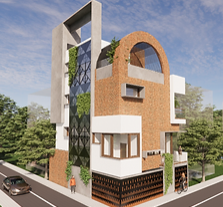Architectural planning is a critical phase in the design and construction of buildings, focusing on the thoughtful arrangement of spaces to meet functional, aesthetic, and regulatory requirements. It involves a systematic approach to organizing the built environment, considering various factors such as site conditions, user needs, sustainability, and future growth. This process is fundamental to ensuring that a building is not only structurally sound but also enhances the quality of life for its occupants and contributes positively to the surrounding environment.
1. Understanding the Site
The first step in architectural planning is understanding the site where the building will be constructed. This involves analyzing the physical characteristics of the location, including its topography, climate, soil conditions, and existing vegetation. The orientation of the site is also crucial, as it influences the building's exposure to sunlight, wind, and views. Architects must consider how the building will fit into its surroundings, both aesthetically and functionally. For example, a building in a dense urban area may need to address issues like noise, privacy, and the impact on neighboring structures, while a rural site might offer more flexibility in design.
2. Defining the Program
Once the site is understood, the next step is to define the program, which outlines the specific needs and functions of the building. This includes determining the types and sizes of spaces required, the relationships between different spaces, and any special requirements, such as accessibility or security. The program is developed in close collaboration with the client to ensure that the building will meet their needs. This phase often involves creating a detailed list of spaces, known as a programmatic diagram, which serves as a blueprint for the subsequent design process.
3. Conceptual Design
The conceptual design phase is where the architect begins to explore different ideas and approaches to meet the program's requirements within the constraints of the site. This phase is highly creative, involving sketches, models, and digital renderings to visualize different possibilities. Architects consider various factors, such as circulation patterns, natural light, ventilation, and the relationship between indoor and outdoor spaces. The goal is to create a design that not only fulfills the functional requirements but also embodies the aesthetic and cultural aspirations of the project.
4. Space Planning
Space planning is a critical aspect of architectural planning, involving the detailed arrangement of interior spaces to maximize functionality and efficiency. This process includes organizing rooms and areas based on their intended use, size, and relationship to one another. For example, in a residential building, the kitchen might be placed near the dining area for convenience, while bedrooms are typically located in quieter parts of the house. Space planning also involves considerations like furniture placement, storage needs, and the flow of movement within the building. Efficient space planning can greatly enhance the usability and comfort of a building.
5. Environmental Considerations
Sustainability is a key consideration in modern architectural planning. Architects must think about how the building will impact the environment, both during construction and throughout its lifecycle. This includes choosing materials that are sustainable and energy-efficient, designing for natural ventilation and lighting, and incorporating renewable energy sources like solar panels. Additionally, the building's orientation and layout can be optimized to reduce energy consumption and enhance comfort. For example, placing windows to capture natural light and breezes can reduce the need for artificial lighting and air conditioning.
6. Regulatory Compliance
Architects must ensure that their designs comply with local building codes and regulations, which govern aspects like safety, accessibility, fire protection, and structural integrity. This requires a thorough understanding of the legal requirements in the area where the building will be constructed. In some cases, architects may need to work with engineers, planners, and other specialists to ensure compliance with complex regulations. This phase also involves obtaining the necessary permits and approvals from local authorities, which can be a lengthy and detailed process.
7. Budget and Cost Management
Another important aspect of architectural planning is managing the project's budget. Architects must balance the client's desires with the available financial resources, making decisions about materials, finishes, and construction methods that will impact the overall cost. This often involves value engineering, where different design options are evaluated based on their cost and performance to find the most cost-effective solution. Budget management also includes contingency planning for unexpected expenses that may arise during construction.
8. Finalizing the Design
Once all these factors have been considered, the architect finalizes the design, creating detailed drawings and specifications that will guide the construction process. This includes plans for all the building's systems, such as electrical, plumbing, and HVAC, as well as detailed drawings of the exterior and interior finishes. The final design is often presented to the client for approval before construction begins. At this stage, the architect may also produce a 3D model or a virtual walkthrough to help the client visualize the finished building.
9. Construction Documentation and Oversight
The final phase of architectural planning involves creating construction documents that will be used by builders and contractors to construct the building. These documents include detailed drawings, specifications, and schedules that outline every aspect of the construction process. The architect may also be involved in overseeing the construction to ensure that the building is being constructed according to the plans. This can involve regular site visits, coordinating with contractors, and addressing any issues that arise during construction.
Conclusion
Architectural planning is a multifaceted process that requires a balance of creativity, technical knowledge, and practical considerations. By carefully considering the site, program, sustainability, regulations, and budget, architects can create buildings that are not only functional and beautiful but also responsive to the needs of their users and the environment. Through a collaborative and iterative process, architectural planning transforms ideas into tangible structures that enhance the built environment and improve the quality of life for those who use them.
